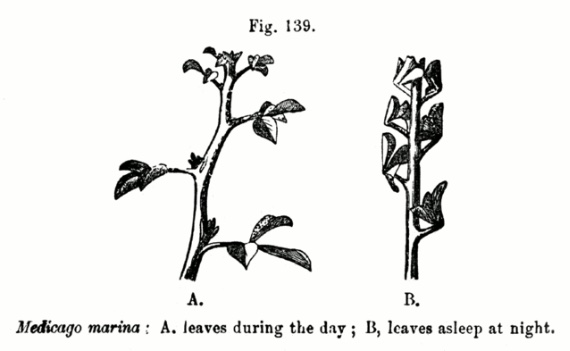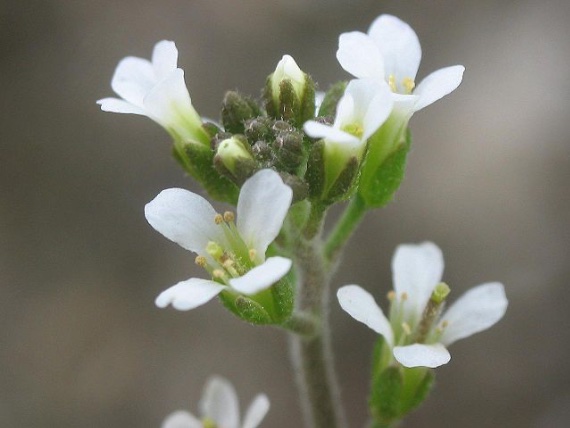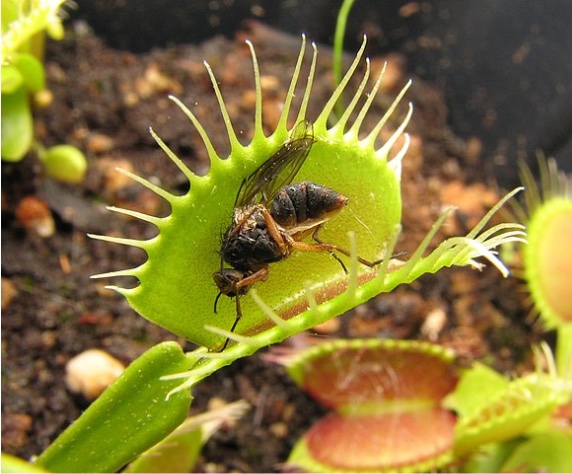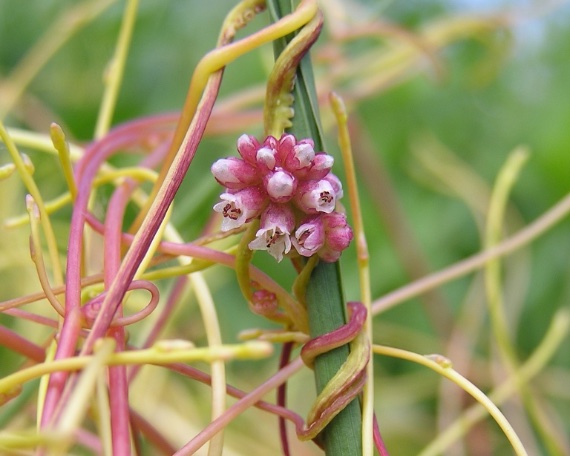Sight, hearing, taste, smell and touch. Our five bodily senses—we actually have more—reside in organs specialised to receive stimuli, the information from which is transmitted to the brain for decision-making. Although many animals surpass us in sensory acuity, we know for certain that this differentiates us from plants, which neither feel nor suffer; when a person doesn’t respond to stimuli we say they are “like a vegetable.” But is this really the case? The truth is that plants are by no means insensitive to their environment: although they lack eyes, ears, tongues, noses or brains, they nevertheless see, hear, taste, smell and much more, and like us make decisions accordingly. The study of the sensory repertoire of plants is a growing scientific field, though its origins are ancient.
As is often the case in biology, to find the roots of plant perception we must go back to Charles Darwin. Late in life, the naturalist published in 1880 what was to be one of his last books, The Power of Movement in Plants, in collaboration with his son Francis, a botanist. Expanding on earlier work on climbing plants, the two experimented with tropism—the attraction of plants to stimuli—and nutation—the differentiated growth of their various parts that moves them towards stimuli.

Father and son highlighted that the sensitivity to light, touch and gravity of plants was similar to that of animals. Like us, plants slumber: nyctinastia is their sleep, during which they adopt positions different from those of the day. In a letter to his friend, the botanist Joseph Hooker, Darwin lamented that during their experiments they had “killed or badly injured a multitude of plants.” The Darwins went so far as to suggest that the radicle, the embryonic root emerging from the seed, acted “like the brain of one of the lower animals,” “receiving impressions from the sense organs and directing the several movements.”
AN ALMOST ANIMAL-LIKE INSTINCT
The conclusions of that work, intended to support the theory of natural selection, were too advanced for its time; as Francis noted in his extensive publication on his father’s life and correspondence, the book was ignored by the orthodox physiology of the day and rejected by some scientists. And yet, notwithstanding the fact that plant tropisms had been known about since ancient times, other authors less prominent than Darwin had already written on the subject. In 1867, the Italian botanist Federico Delpino defended the use of the same terms used for animals, applied to the analogous capacities in plants, including a questionable “instinct,” as it implied sensitivity and response beneath that apparent immobility.
The sensitivity and responsiveness of plants are undeniable, as demonstrated by a vast body of research that stretches from the time of those pioneers to the present day. Plant biologist Simcha Lev-Yadun, from the University of Haifa (Israel), lists for OpenMind the senses that we tend to think of as exclusive to animals, but which also exist in plants: they see, hear, smell and taste, and of course respond to touch.
Plant vision is rudimentary; they don’t have eyes and can’t focus images, but they detect light thanks to pigments in their cells that react to certain wavelengths, or colours. Pigments called phytochromes are sensitive to infrared radiation, beyond the light visible to us. This radiation is emitted as a result of photosynthesis, so plants can see the light emitted by others. “By this, they sense their neighbours and decide about growth, architecture, defence, reproduction,” says Lev-Yadun.
The influence of light is thus essential to plant life: shoots grow towards it, roots move away from it, and its intensity, direction—as in sunflowers—and duration determine plant behaviour, from flowers opening in the daytime to germination, flowering and leaf fall in autumn. This ability not only to detect light and dark cycles, but also to compute their progression during the day and throughout the year in order to make decisions about their growth, depends on a class of plant hormones called auxins, discovered in the 1920s and whose existence was already intuited by Darwin.
REACTION TO SOUND AND VIBRATION
While the response of plants to light is well known, their sensitivity to sound is even more surprising. Plants such as the herbaceous Arabidopsis thaliana, a plant used in experiments that is the botanical equivalent of the laboratory mouse, produce defensive chemicals when attacked by a herbivorous insect. Experiments have shown that simply by recording the sound of chewing and transmitting it to the plant through vibrations, the plant reacts by secreting the same compounds. It is not the only sound they can recognise; we know that plant roots move towards leaky pipes because they follow the moisture. But even if the pipe is not leaking, they are also able to find it by the sound produced by the water moving inside: they use this vibration as a first approximation, until the root touches the water.

In these cases, the vibrations or noises travel through the soil, but other studies are revealing that plants also respond to airborne sounds, just like animal hearing. For example, within just three minutes, flowers increase the sweetness of their nectar when they hear the buzzing of a flying bee, the insect that pollinates them. Today, research is underway into whether faint sounds emitted by plants, such as those produced by water bubbles in their vascular tissue, could be heard by others and form a system of acoustic communication.
The reaction to moisture, a physicochemical stimulus, is also a response analogous to our senses of touch or smell/taste. As for the former, climbing plants vary their growth depending on whether or not they have a support to climb onto. They also react to being touched, like the carnivorous Venus flytrap, or to being injured. “When wounded, plants can distinguish between the mechanics, by insects or by mammals, according to the factors involved, such as mammalian saliva, insect chitin,” says Lev-Yadun. “Accordingly, they up-regulate their specific defences.” And like us, they are also sensitive to wind and temperature. Experiments suggest that stimuli can even create something akin to a memory.

A SYSTEM OF UP TO 15 SENSES IN ADDITION TO THE CLASSICAL ONES
As for chemical stimuli, which we detect in soluble form by taste or in the air by smell, plants also “smell various molecules”, says the researcher; “for instance, when their neighbours are wounded and emit methyl jasmonate,” a volatile compound that serves as one of the chemical signals of communication in the plant world. “When they smell it, they raise their chemical defence, and even structural defences,” Lev-Yadun adds. The parasitic plant Cuscuta pentagona smells the volatile compounds emitted by the tomato plant in the air to locate and cling to it.

Plants are also sensitive to gravity, and can perceive oxygen, CO2, electromagnetic fields… Stefano Mancuso, one of the leading researchers in this field, counts up to 15 senses in addition to the five classic ones we know. And bearing in mind that with all this sensory system they do things like recognise their relatives, cooperate with each other, defend themselves against their enemies and, in short, make decisions, it is not unusual for an increasingly broad scientific field to talk about the intelligence of plants, or plant neurobiology. And although the latter is a zoocentric term that does not convince many, the truth is that even without a brain they still resemble us: they have a system of electrical communication between their cells, like our neurons, and they use chemical neurotransmitters such as glutamate and others that our nerve cells also use.
Of course, all this has led to sometimes dubious extremes. In 1811, the botanist James Perchard Tupper anticipated both Darwin, by writing about sensation in plants, and Delpino, by talking about instinct, but went so far as to suggest a kind of plant consciousness, an idea that others, such as the psychologist Gustav Fechner extended to emotions and even “the soul”. In the 1960s, CIA interrogator Cleve Backster applied polygraph or lie detector techniques to plants, claiming that they showed human-like reactions, and could even read thoughts.
In 1973, Peter Tompkins and Christopher Bird’s book The Secret Life of Plants presented Baxter’s experiments—which could not be replicated by scientists—in a mystifying light that spawned an entire paranormal and parapsychological school of thought on telepathy, emotions and consciousness in plants, embraced by animism and the New Age. The fact that some scientific researchers in this field add spiritual, mystical and shamanic elements to their discourse is so uncomfortable for others that they decline to comment on it, while some attempt to draw the line between science and the rest. For example, some experts make it clear that plants react to sound if it is ecologically relevant, such as the buzzing of a bee. As for the music of Mozart, science has yet to prove that plants are attuned to it.
Comments on this publication